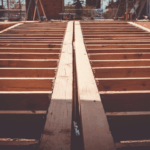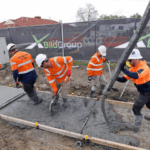Mitigating Damage from Severe Winds
We chat to Dr David Henderson, chief research engineer of the Cyclone Testing Station (CTS) about severe wind events research and One House to Save Many.
One House to Save Many is a prototype house created to withstand a variety of extreme weather events. The house was produced by Suncorp and designed in collaboration with James Cook University’s Cyclone Testing Station, Room11 Architects and the CSIRO, Australia’s national science agency. Learn more

GALLERY
What does your role entail?
Along with the CTS team, I test everything to do with severe wind event damage, from broken screws to complete houses. Specifically, we undertake “damage surveys” following severe weather (such as cyclones, tornados, thunderstorms and hail) so that we can determine the good and bad features of traditional homes and the materials used to make them. We conduct tests in the lab to develop appropriate codes and standards for designers, builders and manufacturers. The CTS team deploys anemometers in the path of cyclones crossing the coast to measure the wind impacting homes and to understand the forces homes need to withstand.

Why do you think this type of research is important?
Severe wind events damage and devastate communities in Australia and worldwide.
We investigate wind events and conduct research so that buildings can be designed to resist severe wind loads and driving rain.
What are some recent findings you have made?
Despite being built to resist wind loads, a lot of the damage to the interiors of contemporary buildings is due to wind-driven rain. However, this is assuming that these buildings can resist wind loads if a window or door fails, causing a sudden opening in the building envelope, allowing the wind pressure inside and greatly increasing the load the house has to resist. The test is to identify if the structure can remain intact and protect the occupants. Houses in Wind Region B have not typically been designed for this, as highlighted by the recent impacts from Tropical Cyclone Seroja that damaged homes and buildings. We found that these houses were not designed to resist the large loads that occur when the building is pressurised from an opening on a windward wall.

What could these discoveries result in?
Improvements in design and construction for homes and other buildings.
What are some of the main problems with Australian houses when it comes to being cyclone-resilient?
Contemporary houses built to current standards are generally designed and constructed with
the minimum requirement for strength. They are usually not designed to keep wind-driven rain out, which results in damages to interiors such as collapsed ceilings, wall and floor linings and contents. Most doors are not wind-rated and there is little protection for windows from wind-driven debris.
Our houses are complex systems that have many components. They need to be maintained so they can keep people safe and remain functional during severe storms. Just like our cars, buildings need regular checks and maintenance. Inspections of the building’s structure and cladding, along with pest inspections, should be undertaken before its purchased or leased. Then inspections should occur at regular internals every few years.
What was your role in One House to Save Many?

Along with the The Cyclone Testing Station, my role was to provide guidance on the design for mitigating damage from severe wind loads, wind-driven debris and wind-driven rain, based on the CTS’s research during many years. The CTS conducted various tests to demonstrate the issues of dynamic wind pressure load cycles to roof cladding, wind-driven debris impacts to walls, and the amount of rain water that can be driven into homes. The mitigation measures such as wider and secure flashings, debris screens and robust doors that were used in One
House to Save Many, can be used on existing homes today.
Why do you think this is an important initiative?
It’s important to raise awareness about the damage that can be caused to homes and buildings as the result of severe cyclones and storms. This message is important for everyone from homeowners, builders and designers to regulators and manufacturers. It is an excellent platform for engaging with people to raise awareness of improving the resilience of their homes.
What have you concluded from embarking on this research and how can it be applied to the building/architecture industry?
The aspects for mitigating damage from wind load, wind-driven debris and wind-driven rain are all existing techniques and methods that can be applied to buildings now.
When do you think we will be able to start implementing these strategies in residential buildings on a regular basis?
The design strategy of protecting the building envelope can be used now in existing homes and new builds.
What are some simple things that a homeowner, builder or architect can do to make their new build or renovation more cyclone-resilient?
Look beyond the minimum requirements in the building code and employ additional strategies to make your house more resilient. Protect the building envelope — for example, use robust, cyclone-rated window shutters or screens. Lastly, undertake regular maintenance of
your home.
For more information
Greenhouses designed to nurture a more sustainable future for Australia. Established in 2007 by visionary entrepreneur John Herrick, Winter ...
Work is set to begin on a new 12-storey mixed-use affordable housing development in Adelaide’s inner north-west, marking ...
Frame Garden Café, known as Tanatap, represents another prototype in an evolving series of multi-level greenspaces that challenge ...
Federal housing schemes, state reforms and persistent affordability challenges are defining Australia’s property outlook for 2026, according to ...
RMIT researchers have demonstrated that concrete made with biochar derived from spent coffee grounds can deliver significant carbon ...












